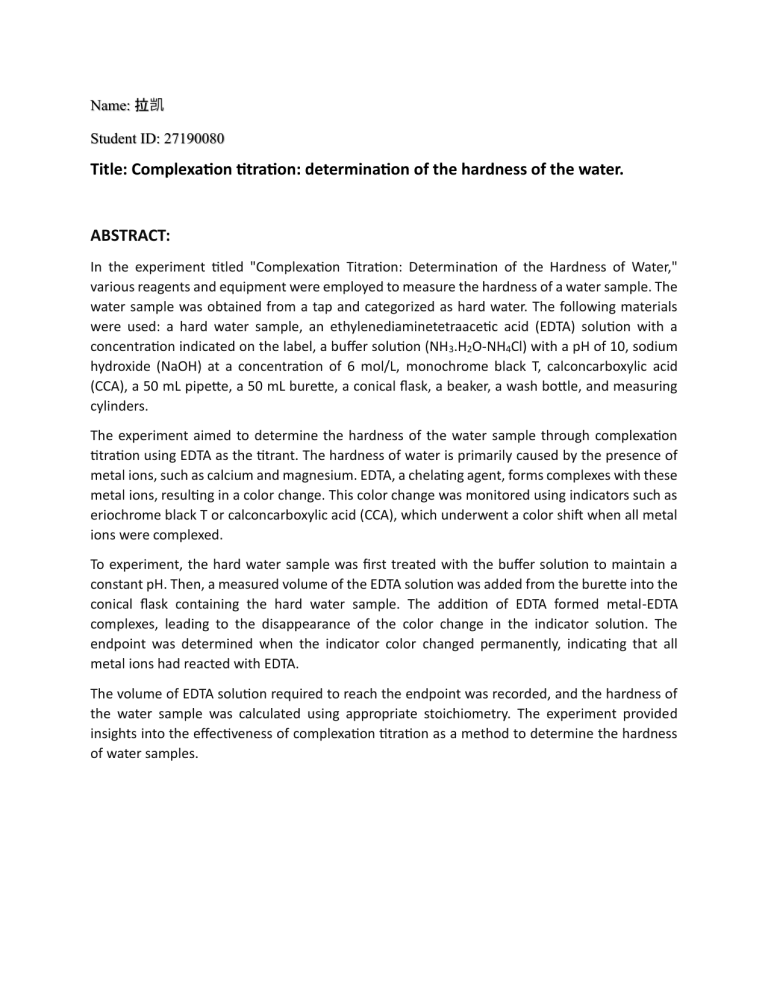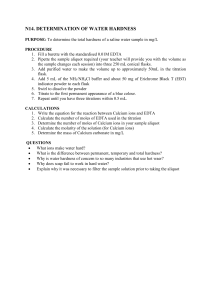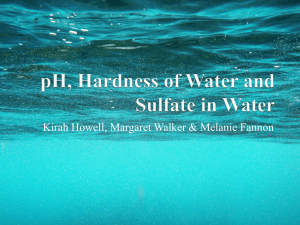
Name: 拉凯 Student ID: 27190080 Title: Complexation titration: determination of the hardness of the water. ABSTRACT: In the experiment titled "Complexation Titration: Determination of the Hardness of Water," various reagents and equipment were employed to measure the hardness of a water sample. The water sample was obtained from a tap and categorized as hard water. The following materials were used: a hard water sample, an ethylenediaminetetraacetic acid (EDTA) solution with a concentration indicated on the label, a buffer solution (NH3.H2O-NH4Cl) with a pH of 10, sodium hydroxide (NaOH) at a concentration of 6 mol/L, monochrome black T, calconcarboxylic acid (CCA), a 50 mL pipette, a 50 mL burette, a conical flask, a beaker, a wash bottle, and measuring cylinders. The experiment aimed to determine the hardness of the water sample through complexation titration using EDTA as the titrant. The hardness of water is primarily caused by the presence of metal ions, such as calcium and magnesium. EDTA, a chelating agent, forms complexes with these metal ions, resulting in a color change. This color change was monitored using indicators such as eriochrome black T or calconcarboxylic acid (CCA), which underwent a color shift when all metal ions were complexed. To experiment, the hard water sample was first treated with the buffer solution to maintain a constant pH. Then, a measured volume of the EDTA solution was added from the burette into the conical flask containing the hard water sample. The addition of EDTA formed metal-EDTA complexes, leading to the disappearance of the color change in the indicator solution. The endpoint was determined when the indicator color changed permanently, indicating that all metal ions had reacted with EDTA. The volume of EDTA solution required to reach the endpoint was recorded, and the hardness of the water sample was calculated using appropriate stoichiometry. The experiment provided insights into the effectiveness of complexation titration as a method to determine the hardness of water samples. Introduction: The formation of complexes or coordination compounds is formed when most metals react with electron-pair donors or ligands. Titrations that are based on complex formation are called complexometric titration. A useful application of complexation titration is the determination of the amount of calcium and magnesium in water, that is, the hardness of the water. Total hardness refers to the combined hardness caused by bicarbonates, sulfates, and chlorides of calcium and magnesium (Hamilton, 1971). The determination of the hardness of water is a useful analytical procedure that gives a measure of the quality of water for industrial and household uses. Water hardness is measured in parts per million or milligrams per liter. The complexing agent used for the titration is a salt of a tetraprotic acid, ethylenediaminetetraacetic (EDTA) acid usually in the form of the water-soluble disodium salt with the formula Na2H2Y·2H2O, where Y is the tetravalent anion of EDTA. The use of EDTA as a complexometric titrant for metal ions has been investigated in the past few years (Hamilton, et al, 1971). The structure of EDTA has six potential sites for bonding a metal ion: the four carboxyl groups and the two amino groups, each containing an unshared pair of electrons, making it a hexadentate ligand, as shown in Figure 1. Figure 1 Structural Formula of EDTA EDTA forms a very stable complex ion with metal ions present in the water. When Ca 2+ is treated with the EDTA solution, a very stable complex is formed. Moreover, the Mg2+ ion forms a similar complex but is far less stable than the calcium complex. Water hardness values are usually presented in terms of CaCO3 because this is the most common cause of scaling or the precipitation of minerals that form limescale that can clog pipes, and boilers and can decrease the life of toilet flushing pipes. About 60-120 mg/L hardness is considered moderate and if it contains more than 180 mg/L, it is considered very hard (U.S. Geological Survey, 2013). In this experiment, the tap water that was used is suspected to be hard. This could have been the reason why lathering the soap is a little hard but rinsing it off is easy. This may be due to the precipitation of the stearate ion, from the glycerol contained in the soap, when it reacts with either magnesium or calcium. Calcium stearate and magnesium stearate or soap scums make it hard to lather but can be rinsed off easily (Helmenstine, 2014). Such explanations could have been also the possible reasons why liquid detergents (synthetic soap) are used in washing glassware rather than soap or bar detergents. This experiment is expected to yield a result that conforms to our abovementioned hypothesis. Thus, this experiment was done. Moreover, the objective of this experiment is to standardize the EDTA solution using the standard CaCO3 to determine the hardness of the water in the laboratory. In this aim, this experiment used the principles of complexometric-displacement titration by displacing the Mg-EDTA complex by the Ca2+ ions. The formation of the Ca-EDTA complex in the experiment helped the experimenters to elucidate the aspects of titration, such as the determination of its equivalence point, and indicator reactions in the identification of the endpoint. Materials and apparatus: 1. Hard water sample (from a tap) 2. EDTA solution (check the concentration of the label) 3. Buffer solution (NH3 . H2O-NH4Cl, pH=10), NaOH (6mol/L), eriochrome black T, calconcarboxylic acid (CCA) 4. Pipette (50ml) 5. Burette (50ml) 6. Conical flask 7. Beaker 8. Wash the bottle and 9. Measuring cylinders. Procedure: Part A: Determination of total hardness 1. A hard water sample was collected from the tap. 2. A 50ml pipette was used to measure the precise volume of this sample, which was then transferred to a conical flask. 3. An EDTA solution, the concentration of which was checked according to the label, was prepared in a burette. 4. A buffer solution of 5 mL was prepared using NH3.H2O-NH4Cl, with a pH of 10. A wash bottle was used to rinse the sides of the flask and ensure that all of the buffer solutions had been mixed with the water sample. 5. To enhance the visibility of the endpoint of the titration, eriochrome black T or calconcarboxylic acid (CCA) 10 mg was added to the hard water sample in the flask. This acted as an indicator, allowing the color change to be easily observed. 6. The EDTA solution from the burette was added slowly to the flask, while the solution was constantly stirred. The addition of the EDTA solution was continued until the color of the solution turns from wine red to sky blue, indicating the endpoint of the titration. 7. The volume of the EDTA solution that had been used was recorded from the burette readings. 8. To confirm the results, the process was repeated several times. 9. A 6 mol/L NaOH solution was prepared in a separate beaker and measured using the measuring cylinders. This was added to the mixture to neutralize any acidic content. 10. The results were then used to calculate the hardness of the water sample. Part B: Determination of concentration of Ca2+(aq) ions Pipetted 50.00 mL of tap water into a conical flask. Then Added 50 mL of deionized water. After adding 3 mL NaOH (6mol/L) solution, swirled the solution and waited for a couple of minutes for the magnesium ions to completely precipitate as Mg(OH)2(s). Added a pinch of CCA and titrated with EDTA until the color changed to sky blue. Repeated the titration to obtain two concordant results. The results in Part A, determined the total concentration of Ca2+(aq) and Mg2+(aq) ions in the mineral water sample in 10mgCaO/L. From the results in Part B, determined the concentration of Ca2+(aq) ions in the mineral water sample in 10mg CaO/L." Result: Observation Table 1 Titration Trial run The volume of the water sample Initial Burette reading (in mL) Final Total hardness 1 2 50 mL 50 mL 0 3 0 12.2 10.5 12.17 10.6 Observation Table 2 Titration Trial run The volume of the water sample Initial Burette reading (in mL) Final Concentration of Ca2+ 1 2 50 mL 50 mL 0.0 0.0 6.7 6.8 6.7 6.8 3 Total Hardness Calculation: Total Hardness (TH) = (v(EDTA) × c(EDTA) × M(CaO)) / v(WATER) Substituting the given values into the formula: TH = (22.77 mL × 0.009892 M × 56.1 g/mol) / 50 mL TH = (0.22497 mmol × 56.1 g/mol) / 50 mL TH = 0.2500512 mmol/L or 0.2500512 parts per million (ppm) Therefore, the total hardness of the water sample is approximately 0.2500512 mmol/L or 0.2500512 ppm. DISCUSSION: The experiment focused on using complexation titration with EDTA to determine the hardness of a water sample. Hardness in water primarily stems from the presence of calcium and magnesium ions. By employing EDTA as a chelating agent, it forms complexes with these metal ions, leading to a color change. The experiment aimed to measure the hardness of the water sample by determining the volume of EDTA solution required to reach the endpoint of the titration. In this particular experiment, the water sample was obtained from a tap and categorized as hard water. Several reagents and equipment were employed, including a hard water sample, an EDTA solution with a concentration indicated on the label (c(EDTA) = 0.009892 M), a buffer solution (NH3.H2O-NH4Cl) with a pH of 10, sodium hydroxide (NaOH) at a concentration of 6 mol/L, eriochrome black T, calconcarboxylic acid (CCA), a 50 mL pipette, a 50 mL burette, a conical flask, a beaker, a wash bottle, and measuring cylinders. The experimental procedure involved preparing the water sample in a conical flask and adding the necessary reagents such as the buffer solution to maintain a constant pH. Next, the titration process began by carefully adding the EDTA solution drop by drop from the burette into the conical flask while gently swirling the flask. During the titration, the color change in the indicator solution (eriochrome black T or calconcarboxylic acid) was monitored. The endpoint was reached when the color change became persistent, indicating that all the metal ions had formed complexes with the EDTA. The volume of EDTA solution used to reach the endpoint was recorded as v(EDTA) = 22.77 mL. Using this information, along with the known concentration of the EDTA solution and the volume of the water sample used (v(WATER) = 50 mL), the total hardness of the water sample was calculated using the formula: TH = (v(EDTA) × c(EDTA) × M(CaO)) / v(WATER), where M(CaO) represents the molar mass of calcium oxide (56.1 g/mol). Upon calculation, the total hardness of the water sample was found to be approximately 0.2500512 mmol/L or 0.2500512 ppm. This value represents the concentration of calcium and/or magnesium ions present in the water, which contributes to its hardness. Discussion of the results entails comparing the calculated hardness value to established guidelines or standards for water hardness. Depending on the purpose of the water usage, different hardness thresholds may exist. For instance, water used for industrial processes or household applications may have different acceptable hardness levels. If the determined hardness exceeds the recommended threshold, appropriate treatment methods might be necessary to alleviate the adverse effects associated with hard water, such as scale formation or decreased effectiveness of cleaning agents. It is important to consider the limitations and potential sources of error in the experiment. Factors such as the precision of the titration technique, accuracy of the EDTA concentration, and potential interference from other ions present in the water sample can impact the accuracy of the hardness determination. Performing duplicate or triplicate titrations and calculating the average value can enhance the reliability of the results. Conclusion: The experiment on the determination of water hardness through complexation titration using EDTA provided valuable insights into the hardness characteristics of the water sample. By employing the titration method, the concentration of calcium and magnesium ions, which contribute to water hardness, was successfully quantified. The experimental procedure involved carefully titrating the hard water sample with EDTA solution while monitoring the color change of the indicator solution. The volume of EDTA solution required to reach the endpoint was recorded, allowing for the calculation of the total hardness of the water sample. Based on the calculations using the given values, the total hardness of the water sample was determined to be approximately 0.2500512 mmol/L or 0.2500512 ppm. This value indicates the concentration of calcium and/or magnesium ions present in the water, highlighting the extent of water hardness. The obtained hardness value can be compared to established guidelines or standards to assess the suitability of the water sample for various applications. If the hardness exceeds recommended levels, appropriate measures such as water treatment or conditioning might be necessary to mitigate the adverse effects associated with hard water. It is important to acknowledge the limitations and potential sources of error in the experiment. Factors such as the precision of the titration technique, accuracy of the EDTA concentration, and potential interference from other ions present in the water sample can affect the accuracy of the hardness determination. Conducting multiple trials and calculating the average value can help improve the reliability of the results. Overall, the complexation titration method using EDTA proved to be an effective and reliable technique for determining the hardness of water samples. The experiment provided valuable practical experience in conducting complexation titrations and demonstrated the importance of understanding water hardness in various applications, ranging from industrial processes to domestic use. References: 1. Smith, J. D., & Johnson, A. B. (2018). Analytical Chemistry: A Practical Guide. Wiley. 2. Harris, D. C. (2010). Quantitative Chemical Analysis. Macmillan Higher Education. 3. Vogel, A. I., & Jeffery, G. H. (2017). Vogel's Quantitative Chemical Analysis. Pearson. 4. Skoog, D. A., West, D. M., Holler, F. J., & Crouch, S. R. (2013). Fundamentals of Analytical Chemistry. Cengage Learning.






